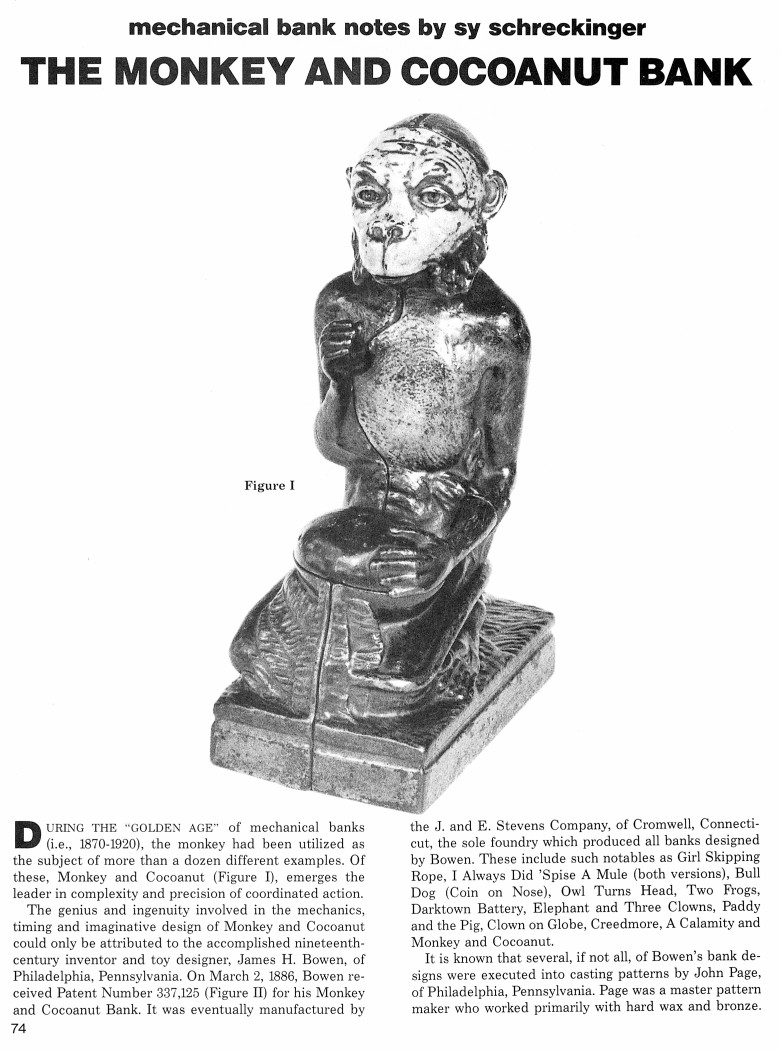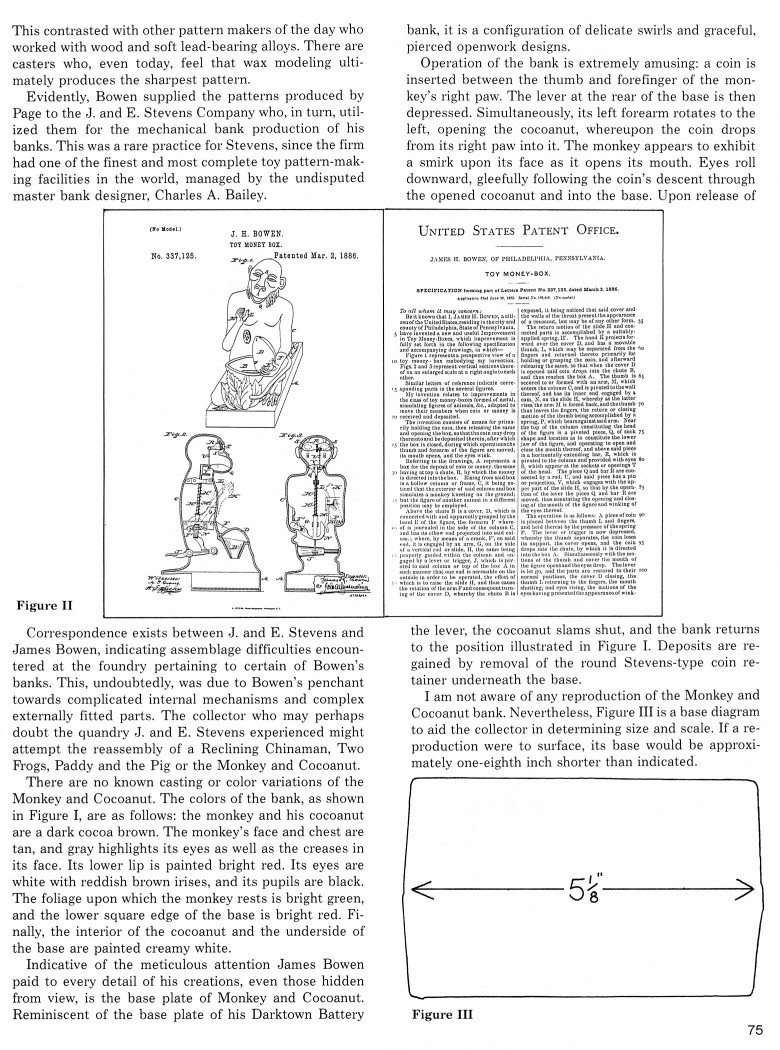|
The Monkey and Cocoanut Bank
by Sy Schreckinger – ANTIQUE TOY WORLD Magazine – April, 1990
During the “Golden Age” of mechanical banks
(i.e., 1870-1920), the monkey had been utilized as the subject of more
than a dozen different examples. Of' these, Monkey and Cocoanut (Figure
I), emerges the leader in complexity and precision of coordinated action.
The genius and ingenuity involved in the mechanics, timing and
imaginative design of Monkey and Cocoanut could only be attributed to the
accomplished nineteenth-century inventor and toy designer, James H. Bowen,
of Philadelphia, Pennsylvania. On March 2, 1886, Bowen received Patent
Number
337,125 (Figure II) for his Monkey and Cocoanut Bank. It was
eventually manufactured by the J. and E. Stevens Company, of Cromwell,
Connecticut, the sole foundry which produced all banks designed by Bowen.
These include such notables as Girl Skipping Rope, I Always Did 'Spise A
Mule (both versions), Bull Dog (Coin on Nose), Owl Turns Head, Two Frogs,
Darktown Battery, Elephant and Three Clowns, Paddy and the Pig, Clown on
Globe, Creedmore, A Calamity and Monkey and Cocoanut.
It is known that several, if not all, of Bowen's bank designs were
executed into casting patterns by John Page, of Philadelphia,
Pennsylvania. Page was a master pattern maker who worked primarily with
hard wax and bronze. This contrasted with other pattern makers of' the day
who worked with wood and soft lead-bearing alloys. There are casters who,
even today, feel that wax modeling ultimately produces the sharpest
pattern.
Evidently, Bowen supplied the patterns produced by Page to the J. and
E. Stevens Company who, in turn, utilized them for the mechanical bank
production of his banks. This was a rare practice for Stevens, since the
firm had one of the finest and most complete toy pattern-making facilities
in the world, managed by the undisputed master bank designer, Charles A.
Bailey.
Correspondence exists between J. and E. Stevens and James Bowen,
indicating assemblage difficulties encountered at the foundry pertaining
to certain of Bowen's banks. This, undoubtedly, was due to Bowen's
penchant towards complicated internal mechanisms and complex externally
fitted parts. The collector who may perhaps doubt the quandary J. and E.
Stevens experienced might attempt the reassembly of a Reclining Chinaman,
Two Frogs, Paddy and the Pig or the Monkey and Cocoanut.
There are no known casting or color variations of the Monkey and
Cocoanut. The colors of the bank, as shown in Figure I, are as follows:
the monkey and his cocoanut are a dark cocoa brown. The monkey's face and
chest are tan, and gray highlights its eyes as well as the creases in its
face. Its lower lip is painted bright red. Its eyes are white with reddish
brown irises, and its pupils are black. The foliage upon which the monkey
rests is bright green, and the lower square edge of the base is bright
red. Finally, the interior of the cocoanut and the underside of the base
are painted creamy white.
Indicative of the meticulous attention James Bowen paid to every
detail of his creations, even those hidden from view, is the base plate of
Monkey and Cocoanut. Reminiscent of the base plate of his Darktown Battery
bank, it is a configuration of' delicate swirls and graceful, pierced
openwork designs.
Operation of the bank is extremely amusing: a coin is inserted
between the thumb and forefinger of the monkey's right paw. The lever at
the rear of the base is then depressed. Simultaneously, its left forearm
rotates to the left, opening the cocoanut, whereupon the coin drops from
its right paw into it. The monkey appears to exhibit a smirk upon its face
as it opens its mouth. Eyes roll downward, gleefully following the coin's
descent through the opened cocoanut and into the base. Upon release of the
lever, the cocoanut slams shut, and the bank returns to the position
illustrated in Figure I. Deposits are regained by removal of the round
Stevens-type coin retainer underneath the base.
I am not aware of any reproduction of the Monkey and Cocoanut bank.
Nevertheless, Figure III is a base diagram to aid the collector in
determining size and scale. If a reproduction were to surface, its base
would be approximately one-eighth inch shorter than indicated.
|


